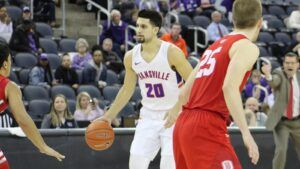 Let me introduce Sam Cunliffe … the ‘new’ Sam Cunliffe … one of the best basketball players at any level that you probably don’t know much about.
Let me introduce Sam Cunliffe … the ‘new’ Sam Cunliffe … one of the best basketball players at any level that you probably don’t know much about.
Cunliffe, the versatile 6-8 guard/forward can do it all – shoot, run the court, pass, rebound, defend. He’s the complete package … but he almost didn’t play basketball at all.
His story starts in a Seattle house occupied by eight girls, not counting his mother, plus a professional track coach father, and Sam. One boy with eight sisters.
“I just thought it was normal. It’s all I ever knew, didn’t know any different,” Cunliffe, now 23 years old, said of his childhood. “It was pretty hectic a lot of the time. But looking back now, it probably made me more patient and understanding of women than most guys my age. Really, I think they sort of treated me like a king.”
Cunliffe did have early interest in basketball.
“When I was probably 4-5 years old, I would watch a Michael Jordan video about his life and career,” he recalled. “I had a Little Tikes (children’s basketball goal) and would try to do everything I saw him doing, trying to do layouts, even sticking out my tongue.”
But, after playing some boys and girls basketball games with his sisters for a while, he started concentrating on another sport – track.
“My dad was a track coach and a couple of my sisters excelled in track,” he said. “So I was around it all the time. I ran track in the Junior Olympics in Des Moines, Iowa and set the long jump world record for 10-year olds at 16 feet, 10 ¾ inches.
“I was really good at it. I never lost. Everybody in my household was doing it, but I didn’t want to. It was getting boring.”
So, Cunliffe’s attention turned back to basketball.
“I was 11 years old and had a bus pass,” he recalled. “So, I rode all over Seattle finding places to play. I didn’t have a trainer and I wasn’t any good at all. Really, I was terrible. But, I had a dream. One day I was going to go from the worst to the best.”
Getting better was a gradual thing. Cunliffe improved in the seventh and eighth grades at O’Dea High, an all-boys Catholic school in Seattle. He played as a 6-1 freshman and was still improving his play. He had a new dream.
“I told people that I was going to be the best player in the state of Washington,” he said. “People that saw me play thought I was crazy.”
The following season, Cunliffe played at Bishop Blanchet, a co-ed Catholic high school in Seattle where he “thought I could play more and become a star.” But due to state of Washington rules, he had to sit out his 10th grade season.
“I couldn’t play, so I constantly worked out,” he said. “I would dribble a ball to the bus stop and dribble it back home. I was dedicated to becoming a better player.”
As a junior, now grown to 6-5, Cunliffe averaged about 20 points per game and was being watched anxiously by opponents. In a game against Rainier Beach High, he scored 30 points, but his team lost the game. After the season, he talked with the head coach of the Rainier team, which was considered among the state’s premier programs.
“My dad thought I should transfer to Rainier Beach,” he recalled. “A lot of the best players went to Rainier Beach every year. A lot went on to play in college and in the NBA.”
So, Cunliffe played his senior season for the Vikings and it proved to be the right move. Having grown to 6-8, he averaged about 26 points per game and was named the state’s Most Valuable Player. Most every ranking service had him as the No. 1 player in Washington.
“He (Cunliffe) was the best player in Washington as a senior and it probably wasn’t even close,” a veteran sportswriter recalled. “He was one of the best high school players to come from this area in long time.”
The dream of that O’Dea High freshman had come true. Cunliffe had become the best player in the state of Washington. But, the next steps in his basketball career weren’t as smooth as people might have expected.
Neither the hometown Washington Huskies nor the in-state Washington State Cougars heavily recruited their state’s best player. In hindsight, Cunliffe feels that was probably because he “was so extremely competitive that it probably made me look like a jerk.” He said that he “wasn’t as good of a teammate as I could have been.”
He received about 15-20 calls per day from college recruiters, but Arizona State’s Bobby Hurley stood out to Cunliffe.
“He (Hurley) was consistent and seemed genuine,” he said. “He showed how much they wanted me to be there. We built a trust.”
So, Cunliffe enrolled at Tempe, but didn’t find things like he thought they would be.
“The speed of the game was so different from high school,” he said. “The game moved so fast. Players and coaches took things differently, everything was so serious. In high school, I could just take the ball and score. In college, there were more plays. You had to determine how to work best within the system.
“I had set unrealistic expectations for myself. I expected to come to college and excel in games like I had done in high school. But that didn’t happen.”
Ten games into his freshman season, Cunliffe had played in every game for Arizona State and scored 23 points against The Citadel. But, he still wasn’t meeting the goals that he had set. He blamed himself. He blamed others. He decided that he needed to make a change.
“I panicked,” he said. “There were people around me, people that influenced me that wanted me to transfer. Looking back, I know that I was too impatient. I didn’t give it enough time. It was an emotional decision. I was too hard on myself, didn’t allow myself to be a freshman.”
So, Cunliffe moved to Lawrence, Kan., to play for Bill Self and the Kansas Jayhawks. He was ineligible due to the transfer and didn’t play much as a sophomore, an experience that he called “super humbling.” Going into his junior season, Self told Cunliffe that he wouldn’t start and might have limited playing time due to the depth and talent on the upcoming team.
“I appreciated his honesty,” Cunliffe said.
So, he withdrew from Kansas and returned to Seattle, saying that he “wanted to enjoy basketball again.” He played in a weekend 5-on-5 tournament with several players with NBA experience and he did well.
Shortly thereafter, he was contacted by Walter McCarty, who had played for the 1996 national champion Kentucky Wildcats, and had also played in the NBA for the New York Knicks, Boston Celtics, Phoenix Suns and Los Angeles Clippers. McCarty was head coach of the Evansville (Ind.) Purple Aces of the Missouri Valley Conference. He wanted Cunliffe to play for Evansville.
Things were looking up for Cunliffe. In the 2019 season, he would be playing for a head coach with NBA experience, who ran an NBA system, where he could continue to improve his skills and be ready to play professionally.
In one of the biggest wins in Evansville basketball history, Cunliffe scored 17 points, including the winning free throws with 6.8 seconds remaining, as the Purple Aces defeated No. 1 Kentucky at Rupp Arena, 67-64. He also scored 25 points against Drake.
But, the excitement didn’t last long. Within a month of the historic win, McCarty was placed on administrative leave due to off-court misconduct charges. The once promising season fell apart and by mid-February, McCarty had been fired. Then, before the 2020 postseason could even be played, COVID-19 hit, most everything in the country and around the world changed, and the future was uncertain, including the next basketball season.
Cunliffe, who had played under three head coaches in three years, decided to opt out of the 2020-2021 season and would prepare for the opportunity to play professional ball.
“When I returned to Evansville after the 2019-2020 season, the feel was different,” he said. “We didn’t know if we would play again. I didn’t want to have another season that turned out to be a disappointment. So, I opted out for the year. I knew that I was ready to play professionally and didn’t intend to transfer again.”
Cunliffe regrets the initial transfer from Arizona State, but wouldn’t change what happened.
“I learned a lot from my experiences,” he said. “I’ve had to take responsibility for my choices. When I did transfer, I thought I was making the best decision for my future at that time, but I wish my perspective had been better back then.
“I’ve learned that you can’t blame other people for the choices that you make. It’s like I had a ‘destination addiction,’ you know where you think things will be better, be different if you change your circumstance. But, I learned that nothing will change until you change things within yourself.
“Looking back, I know that nobody had a gun at my head. I dug some holes for myself. It took me a while to acknowledge that only I could change those things.”
Cunliffe has some things to prove to himself and to others now.
“I understand that some people might have questions about me,” he said. “Am I a good person? Can I be counted on? I can’t change how people think about me until I prove who I am and I realize that can take time.
“On the court, I can do it all. I have shooting accuracy. I can pass, can handle the ball. I can rebound and I can defend. I’ve worked hard to make myself a good overall player.”
What would Cunliffe say are his best attributes to bring to the professional ranks?
“First is my day-to-day attitude and energy,” he said. “Then, I have the ability to score on all three levels. And, I have the willingness and the understanding to make the right play at the right time.”
When Cunliffe’s playing days are over, don’t be surprised to see him in front of a camera. While at Evansville, he broadcast Purple Aces women’s basketball and softball, along with men’s baseball and soccer games on ESPN3.
“That was a lot of fun,” he said. “I really enjoyed it and I was pretty good at it.”
But before that, Cunliffe has something else on his agenda. He enjoys playing basketball and he’s really good at it. And, he’s ready to prove himself at the professional level.
The dream of that 11-year old boy back in Seattle is another one that has come true. He has gone “from the worst to the best.”
One of the best overall basketball players at any level, anywhere.
That’s the ‘new’ Sam Cunliffe.


